
We were walking through a desa* east of Borobudur so I could take some photographs of country life when we heard an animal complaining. When we saw a couple of women, we communicated that we would like follow a pathway 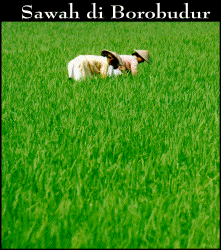 that led in between some homes and asked if it was okay. They said it was, so we walked on. There was a hard, dirt path linking the homes on the side of the street we walked on. It had been swept clean that morning and there was a beautiful grove of large, thick bamboo along a portion of the walk we had. Some of the houses had walls of woven leaves and clay roofs. Many of the houses were built on foundations of cut stone. There were lots of roosters, goats, and many of the houses had a cow in their barn. When we arrived near to the place where we had heard an animal crying out, another lady and several children, who apparently just finished school for the day, greeted us. I asked the woman, who had just come out of a barn that was attached to her house (the livestock were kept in barns like this throughout the desa), if I could take some pictures. After I had taken a few pictures, an old lady who had joined the crowd that was forming came up to me and handed out her hand while saying something in Indonesian. When the Cirebon to Yogyakarta train had made its intermittent stops, children would come out of nowhere and asked the mostly Indonesian passengers for money. It was obvious to me that this woman was doing the same. I said, "no," and turned my back to her to walk away. She responded by hitting me hard (it didn't hurt because I'm fairly big, but it was enough to make me notice) and she said something angrily to me so I hurried away. [*a rural village; desa also refers to the countryside]
that led in between some homes and asked if it was okay. They said it was, so we walked on. There was a hard, dirt path linking the homes on the side of the street we walked on. It had been swept clean that morning and there was a beautiful grove of large, thick bamboo along a portion of the walk we had. Some of the houses had walls of woven leaves and clay roofs. Many of the houses were built on foundations of cut stone. There were lots of roosters, goats, and many of the houses had a cow in their barn. When we arrived near to the place where we had heard an animal crying out, another lady and several children, who apparently just finished school for the day, greeted us. I asked the woman, who had just come out of a barn that was attached to her house (the livestock were kept in barns like this throughout the desa), if I could take some pictures. After I had taken a few pictures, an old lady who had joined the crowd that was forming came up to me and handed out her hand while saying something in Indonesian. When the Cirebon to Yogyakarta train had made its intermittent stops, children would come out of nowhere and asked the mostly Indonesian passengers for money. It was obvious to me that this woman was doing the same. I said, "no," and turned my back to her to walk away. She responded by hitting me hard (it didn't hurt because I'm fairly big, but it was enough to make me notice) and she said something angrily to me so I hurried away. [*a rural village; desa also refers to the countryside]

The first cultural lesson for English speaking visitors to the Javanese traditional centers of Yogyakarta or Solo should be that there is no "v" in the Javanese language. As a result, the island and the people are called "Jawa" by the inhabitants themselves, but the romanized spelling of the name, I presume is a historical legacy of the Dutch who lack the English "w" sound in their alphabet. The spelling of the city name, Yogyakarta, can be explained in the same way. Though the name is pronounced "Jogyakarta", there is no English "j" sound in the Dutch alphabet. A "j" in the Dutch alphabet is pronounced the same as a "y" in the English alphabet. I hope this makes sense to you, because I'm still not sure that it does to me and it took me a couple of months to figure this out.
A more simple lesson is that Bahasa Indonesia and Malay have no English "c", this letter in those two languages is pronounced as an English "ch".

|
We learned from a woman in Solo that the perfect, traditional Javanese man possesses five things in life:
(1) a house for living; (2) a horse, though in modern Indonesia it is more appropriate to own a motorcycle; (3) a wife, so that he may have children, (4) birds, for entertainment; and (5) a weapon, for protection.
|
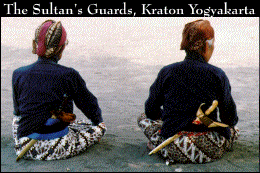
|
The first three are commonly sought after by men in all cultures, but birds and weapons are worth taking a particularly close look at. We've seen a fondness for birds amongst Chinese in China, but the love for birds in parts of Indonesia seemed unparalleled. It was common to see birdcages hung from the roof in front of small shops and homes. Sometimes birdcages were hung from poles some thirty feet high in the air. Later in Java, we learned that birds were supposed to bring the owners a long life, and we could see why. It would be hard to doubt that these birds which were both beautiful and pleasant to listen too, did indeed lengthen their owners' lives.
The traditional weapon in Malay communities, of which Indonesia is the most populous, is the kris or keris. A kris is a long knife that is roughly half as long as swords you may have seen. The blades are distinguished by the waves in them, but have straight blades have also been used since the 12th Century. A cundri is a small kris that some women might conceal in their hair and use for protection. The kris was believed to have special powers and treated with great respect, but since sometime around World War II, the kris disappeared along with traditional clothes for men. Today it is a relic found only in ceremonial dances, tourist productions, and antique shops.
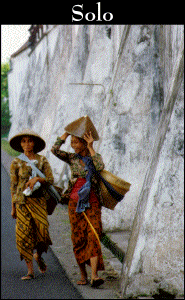

When we travel abroad, some of us are attracted to differences from our own homes. The difficulty of relating what we observe, then, arises from the fact that my interpretation and judgement of what I experienced might be completely different from someone else. With this in mind, I remind the reader once again that I was born and raised in America where the rules of public decorum in regard to this next issue are more rigid and perhaps more ridiculous than most places. In explanation, I would like to preface this next section with two news stories I encountered shortly after my return to America. First I read how some particular jurisdiction deemed it necessary to legalize breast-feeding in public. It seems that, as one commentator suggested, the sexual identity of a woman's breast had reached a height of preeminence overshadowing the maternal identity of the mother's breast. The other story was from a beach community near San Francisco. The city council of this community had decided to impose stiff fines for exposure of genitals or the area between the buttocks (!?) which became progressively more severe for repeat offenders. This measure came about in response to complaints from the local residents that the surfers were revealing themselves when they changed into and out of their wetsuits when they go to the beach to surf (surfers don't wear anything underneath their wetsuits). While these particular laws are aimed at opposing concerns, the concerns themselves are what are the most relevant here.
For Balinese ceremonies, women commonly wear a colorful, lace kebaya with a bra distinctly visible underneath. 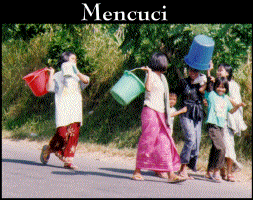 Walking through some kampungs in Java or Bali, I would see older women wearing either just a bra or a bra with an open shirt. More than once, when they saw me they would begin to cover up, but it was clearly only because I was a foreigner that they did so. Women breast-feeding their children do it quite openly. I saw some women that had their shirts wide open while the baby or young child either suckled or just looked away. One time, while walking through a kampung in Cirebon, I saw a young woman bathing in an open-air alcove. She was taking a shower and her back was to me, but I could still see her breast because she was turned slightly. Other times I would see women, young and old, bathing in rice canals or rivers. When driving over a bridge above a river in Yogyakarta, we saw a man bathing with out any concern for the heavy traffic goers seeing his genitals.
Walking through some kampungs in Java or Bali, I would see older women wearing either just a bra or a bra with an open shirt. More than once, when they saw me they would begin to cover up, but it was clearly only because I was a foreigner that they did so. Women breast-feeding their children do it quite openly. I saw some women that had their shirts wide open while the baby or young child either suckled or just looked away. One time, while walking through a kampung in Cirebon, I saw a young woman bathing in an open-air alcove. She was taking a shower and her back was to me, but I could still see her breast because she was turned slightly. Other times I would see women, young and old, bathing in rice canals or rivers. When driving over a bridge above a river in Yogyakarta, we saw a man bathing with out any concern for the heavy traffic goers seeing his genitals.
Indonesian women dress conservatively with many of them using a tudung to cover their hair. It is considered improper for men to show their legs by wearing shorts, though some becak drivers may wear shorts in some areas. On Bali, where Hinduism predominates, the women dress and act equally conservative. When we were on the beach in Kuta, the Balinese gawked at the western tourists in their bikinis, especially those without any bathing suit tops at all.
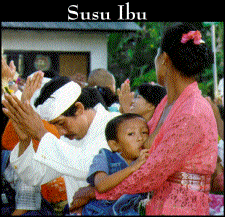 Naturally, coming from a place where it is not common to see young women's breasts in public, I was twisting my neck when I saw anything of the sort out of the corner of my eyes. Women bathe in rivers and canals just as men do because they often don't have running water at home. They breast feed without concern for revealing their breasts because it is unduly burdensome to try and hide their breasts from everyone when doing so. Even though I would look, and was dying to take pictures every time a saw a naked breast, I could see past my cultural conditioning. I realized that what I saw was not so unusual. That it was natural and necessary. I suppose I would have been more aroused if I had the opportunity to be a true "voyeur", unseen by others, but as it was I was constantly being looked at myself because the color of my skin and the western affluence that it represented was an equally rare site for most of the people I encountered. I still wanted to know what a male Balinese youth thought about these common day sites so I asked one high school student we met at a temple ceremony. He had difficulty speaking English so it took longer for us to communicate to each other and we would find ourselves trying to finish or correct his sentences and then be told that we misunderstood. After going on this way for several minutes, he got us to understand that he would feel embarrassed if, having seen a woman bathing in a canal or river, he saw her at a market sometime later. It was surprising to me that he, in the prime of a newly found sex drive, would hold such a strong sense of propriety about something. It was a lesson for me about both his culture and my own.
Naturally, coming from a place where it is not common to see young women's breasts in public, I was twisting my neck when I saw anything of the sort out of the corner of my eyes. Women bathe in rivers and canals just as men do because they often don't have running water at home. They breast feed without concern for revealing their breasts because it is unduly burdensome to try and hide their breasts from everyone when doing so. Even though I would look, and was dying to take pictures every time a saw a naked breast, I could see past my cultural conditioning. I realized that what I saw was not so unusual. That it was natural and necessary. I suppose I would have been more aroused if I had the opportunity to be a true "voyeur", unseen by others, but as it was I was constantly being looked at myself because the color of my skin and the western affluence that it represented was an equally rare site for most of the people I encountered. I still wanted to know what a male Balinese youth thought about these common day sites so I asked one high school student we met at a temple ceremony. He had difficulty speaking English so it took longer for us to communicate to each other and we would find ourselves trying to finish or correct his sentences and then be told that we misunderstood. After going on this way for several minutes, he got us to understand that he would feel embarrassed if, having seen a woman bathing in a canal or river, he saw her at a market sometime later. It was surprising to me that he, in the prime of a newly found sex drive, would hold such a strong sense of propriety about something. It was a lesson for me about both his culture and my own.

